Abstract
This study investigates the perception of postural discomfort experienced by passengers seated in the middle rear seat of a vehicle—an area often overlooked in ergonomic research. A total of 20 participants (12 males and 8 females) were involved in a pilot test using two car models: a City Car (Fiat Panda) and a C-SUV (Renault Arkana). Each participant completed a short on-road ride (~24 min, 11.7 km) in both vehicles. Discomfort was assessed using a 5-point Likert scale, considering both overall and localized body discomfort, as well as other elements/factors, such as those involved in the human–car interaction (e.g., the central tunnel, the headrest, AC vents, and other passengers). The results showed that overall discomfort was significantly higher in the City Car (mean: 3.75 ± 0.72) compared to the SUV (mean: 3.00 ± 1.16). The most affected body regions in the City Car were the arms (mean: 3.95), knees (3.90), and legs/feet (3.55). In the SUV, discomfort was lower across all regions, with the arms (3.15) and knees (3.05) still being notably impacted. Strong correlations were observed between discomfort and several vehicle features: backrest width, headrests, interference with adjacent passengers, and rear air conditioning vents. This study highlights specific ergonomic issues in the middle rear seat and suggests design improvements, including wider backrests and headrests, repositioned air vents, and the inclusion of lateral supports. These findings offer actionable insights for automotive manufacturers to enhance passenger comfort in multi-passenger configurations.
1. Introduction
Today’s global competition has led many automakers to design products based on consumer preferences and satisfaction. Identifying seat features that can improve the driving experience is a key issue for automotive companies. Each component of a car seat is designed by engineers, considering all of its characteristics (e.g., size, material, hardness, color, finish, and the interface with other car components). At the same time, since humans are involved in the process (either as drivers or passengers), all relevant human characteristics must be studied and considered when developing the equipment [1,2,3,4].
Therefore, during the design phase, ergonomic engineers have to evaluate all the aspects that take part in the driving experience. It is needed to fully understand the target user group and its preferences, the environmental conditions in which the driver/user operates (such as road, traffic, and weather), how the driver/user will perform various tasks and the aspects that can positively influence the driver/user expectation such as parts’ quality, craftsmanship, and the brand. So, from this perspective, ergonomic technical, esthetic, and production aspects have become crucial elements in the automotive design process and, therefore, in cars’ choice by the users.
People’s driving habits are changing; they travel longer and more frequently each year [5,6]. The main risk is discomfort or fatigue caused by prolonged driving [7,8,9,10]. Several studies were published on vehicle comfort, particularly referring to the seat, mental stress, and esthetics aspects. For example, in terms of comfort, Reed et al. [11], Kolich [12,13,14], Bubb et al. [15], and Fazlollahtabar [16] emphasized anthropometry as a fundamental design aspect; Naddeo and Memoli [17] and Naddeo et al. [18] focused on driver postural comfort to evaluate accessibility and usability; Vergara and Page [19] assessed the relationship between comfort, back posture, and body movements to evaluate seat comfort; in studies by Seokhee et al. [20], Kolich and Taboun [21], and Zhao et al. [22], postural changes were detected through dynamic body pressure distribution and were used to assess driver discomfort; in studies by Reed et al. [11], Kolich [12], Warska et al. [23], and Naddeo et al. [24], seat stiffness, breathability, and geometry were considered to be the factors that most influence driver comfort.
Further studies reveal that people perceive major physical discomfort in the back, neck, buttocks, and thigh areas [25,26,27].
In [28], the average ride (dis)comfort level regarding accelerations (longitudinal, lateral, and vertical) was stated, and the lack of comfort was also associated with the frequency of the vibration and the intensity of it (in direct proportionality).
Several studies indicated that the vibration transmitted from a vehicle to the human body affects vehicle occupants’ perceptions of seating comfort especially for longer-term (>45 min) driving and riding scenarios [29,30].
Furthermore, it is known that low-frequency vibrations close to 1 Hz are transmitted throughout the body, increasing malaise, while higher-frequency vibrations are attenuated by the human body. It is also interesting to note that monotone continuous low-frequency vibrations increase fatigue, while transient vibrations produce stress [31].
Therefore, physical comfort ranks highly among the factors that influence drivers’ and passengers’ decisions to buy, and car manufacturers consider discomfort as a design requirement that is mainly linked to seats’ design.
So, the literature confirms and offers a lot of studies in which it is demonstrated that comfort is one of the crucial elements in car seat design [32,33,34]. Several types of human–vehicle interaction variables that influence the user’s (dis)comfort were analyzed, such as human factors (age and gender), environmental factors (temperature, noise, and pressure), spatial factors (seat shape), and dynamic motion factors (vibrations). Meanwhile, nothing has been made about the comfort and experience of the car’s middle rear seat. Quattlebaum and Stylidis [35] conducted a preliminary study on perceived comfort in car seats using digital information about the physical components; Hatoum and Ghaddar [36] conducted a study about a rear cooling system using heat pipes embedded in the seat itself to improve passengers’ comfort. People like comfortable seats [37], and in a 4-doors/5-seats car, the middle rear seat is the least desirable, most uncomfortable, and most “un-cool” place in the vehicle. In this paper, a study about the perception of postural discomfort concerning the seating in the middle rear seat of a car was carried out. The discomfort evaluation, considering both overall and localized, was carried out by relating it to seat characteristics and the interaction of human body parts with the interior parts of the vehicles. After a survey, which was aimed at identifying and collecting as much data as possible on the human experience of using such a seat, the study was combined with extensive test sessions. The tests were conducted on the seats of two different car models: a City Car (Fiat Panda) and a C-SUV (Renault Arkana). A total of 20 participants were asked to perform the tests and fill a questionnaire. The paper’s aim was to provide an instrument of investigation of discomfort from the middle rear seat, so a short ride was chosen to perform the experiments. The postural discomfort measurement was assessed by asking participants to rate it on a 5-points Likert scale. The Likert scale is the most often used metric in the evaluation of vehicle seat (dis)comfort; it is easy to understand/administer, and several studies showed good significant results [12,13,21,38,39]. The research questions are as follows: (1) Does the middle rear seat problem exist? (2) What do subjects feel during their experiences? (3) How can we assess the discomfort in the middle rear seat? (4) Is it possible to suggest solutions to reduce discomfort-related issues?
2. Material and Methods
2.1. Purpose
In this study, a methodology to evaluate the effects of the car’s middle rear seat on passenger seating behavior and perceived postural discomfort is shown. The aim was to identify which body parts are most stressed and which elements/factors, involved in the human–car interaction, cause major discomfort.
2.2. Procedure
The procedure was organized in three steps starting from the research questions:
- A general survey was developed to check, firstly, if the problem under investigation is common and, secondly, to identify aspects/factors that could influence the car experience in terms of postural (dis)comfort and physical wellbeing.
- The definition of the best test setup in terms of participants to be involved in the tests, the car to use, the track’s typology, the test procedure, and the development of an adequate questionnaire to be administered at the end of the tests to acquire the necessary data was determined.
- Practical test: Twenty people participated in the practical test. Two different cars were chosen, with journeys lasting between 21 and 26 min.
2.2.1. General Survey
First of all, a brainstorming session was conducted among the authors, experts in the automotive design field, and 10 students who often travel with 4 other people in the car (to/from the university) to identify the main problems experienced by a passenger sitting in the car’s middle rear seat. The output of the brainstorming session was a survey that was spread out, using Google® Forms, among Italian universities (students, teachers, and administrative staff), obtaining 120 answers.
The analysis of the 120 answers led to the definition of the items/issues to be investigated after the following practical test, which was conducted through a questionnaire. The survey concerned demographic information (gender, age, and nationality); the frequency of being a passenger in the middle rear seat; the type of car the interviewee usually travels in; and the trip time. Other questions were aimed at evaluating the central seat in terms of space, the presence of a headrest, visibility, lateral thrusts to which the subject is exposed to when cornering, perceived acceleration when cornering and braking, the climate control system, interference with the vehicle central tunnel and roof, and interference due to the presence of two other passengers on either side. An open question for general comments was added at the end of the form.
2.2.2. Participants
Twenty university students (twelve males and eight females), all volunteers, participated in the practical experiment. None had a history of muscular–skeletal diseases. Participants reported riding in the middle rear seat at least 3 times a month. The main characteristics of the subjects are summarized in Table 1. The subjects were informed of the nature of the tests, and their written consent, in accordance with the ethical standards of the University of Salerno, was obtained.

Table 1.
Demographic data of the participants.
2.2.3. Path and Car
The analysis of survey results gave evidence of more used cars by travelers: the A-segment and a C-SUV segment. For this reason, two cars were chosen to conduct the on-road test: a Fiat Panda, which is a City Car belonging to the A-segment, and a Renault Arkana, belonging to the C-SUV segment. Both Fiat and Renault are classified as “Mass market car brands” in the “car brands pyramid” [40], so they can be considered as belonging to the same car class. The path chosen for testing was a city route that was 11.7 km long. The tests were carried out following the path in Figure 1, located in Fisciano (Salerno). The path included bumps, 90-degree turns, and traffic circles, as well as stop signs and downhill and uphill sections, in order to experience, as a passenger, the main critical road conditions that could bring a lower comfort condition.
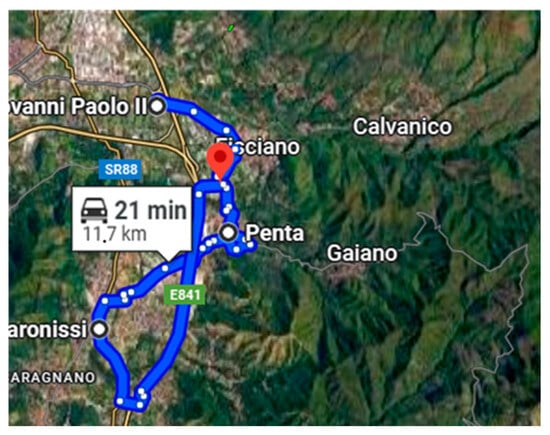
Figure 1.
Selected 11.7 km journey.
For the tests, only two drivers, one for the SUV and one for the City Car (heights equal to 178 cm and 175 cm, respectively), were chosen. In this way the driver/passenger layout for all the tests was almost the same. The drivers, in both cars, positioned the front seat according to their preferences to drive comfortably. The inclination of the backrest was 23° for the SUV and 25° for the City Car. The same inclination was then set for the front seat/passenger. The rear seats of the used vehicles, instead, were fixed as there were no possibilities of adjustment of the rear seat.
2.2.4. Test Procedure
The experiments were organized in two sessions, one for each car. During the implementation of dynamic tests, the two cars followed the same path and maintained, as much as possible, a similar speed (in compliance with the speed limits for urban roads, with an average speed of around 3435 km/h; for interurban roads, an average speed of 4780 km/h; for highways, an average speed of 11,020 km/h). The testing order was planned for each participant according to the Latin square method [41] to randomize the order while keeping the experiments’ repeatability. Driving was moderate (at a normal road speed and never overtaking any other cars), thus also reflecting the impact of road traffic. Each test lasted approximately 21 to 26 min. It helped to not consider the “time effect” on the evaluation. The experiment took place in May, with a slight mugginess in the air and a temperature of 26 °C. To evaluate the discomfort caused by the direct air jet targeted at the middle rear seat, the air conditioning was utilized and set to 21 °C. Both cars were equipped with a camera system so that the whole test could be recorded, and then frames were captured.
In Figure 2, the cameras’ point of view (red arrow) and the legs’ space, transverse and horizontal (in mm), are highlighted. The cameras were placed at the same point for both cars so that the passengers could be filmed from the same angle for the different tests. The camera used for the tests conducted on the Fiat Panda was that of the Google Pixel 7 smartphone, while a Xiaomi Mi action camera was used for the tests on the Renault Arkana.

Figure 2.
Cars equipped with cameras and leg space information (width and frontal legroom). The Fiat Panda on the left and the Renault Arkana on the right.
In Figure 3 some frames from the video footage captured during the tests are reported. In all the tests and for both the cars, it was noted that participants assumed the same posture: hands on the legs.

Figure 3.
Frames from the videos. The Fiat Panda on the left and the Renault Arkana on the right.
For the acceleration data, a Samsung smartphone with the Phyphox app installed was used [42]. It allows access to the accelerometers of the smartphone with a maximum sampling rate of 100 Hz. The smartphone was chosen because it was non-intrusive and car-independent (https://phyphox.org/, accessed on 25 July 2025). A screenshot of the application during data recollection is included in Figure 4.
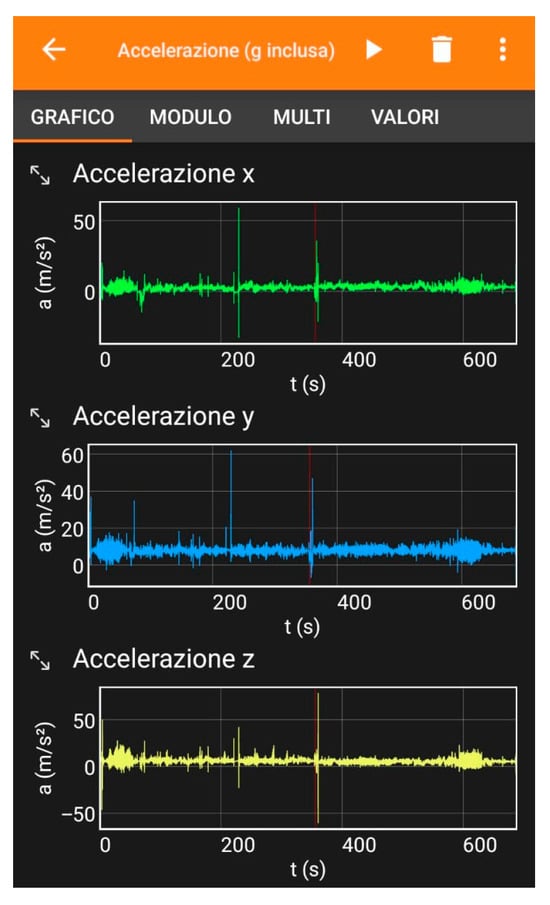
Figure 4.
Data acquisition device. An example of a screenshot during data acquisition.
2.2.5. Questionnaire
The questionnaire was developed considering the Tourangeau model [43] for the interviewer answer process, that is, considering the four cognitive stages or process while answering the question: comprehension of the question, recall of memories, retrieval and judgment for attitude questions, the translation of judgments into responses. Pilot tests were conducted, and a screen of the questions was performed to minimize survey errors (variance and bias) [44,45,46,47,48]. All twenty participants in the experiment promptly completed an online questionnaire using the Google Forms platform. This questionnaire aimed to gather their responses regarding the level of physical discomfort experienced while sitting in the middle rear seat during the car ride. The participants were asked to respond to the questionnaire twice: once by selecting the SUV option, referring to the experience in the C-SUV vehicle, and once by responding based on the experience in the City Car.
The questionnaire was divided into three sections:
- The first section focused on gathering anthropometric data from the participants (gender, age, height, and weight) and the tested vehicle, either an SUV or a City Car.
- The second section aimed to evaluate the discomfort caused by the seat itself and by the interiors’ parts the participants interacted with.
For the seat, participants evaluated the perceived discomfort related to the width, depth, and stiffness of the seat cushion; the height and width of the backrest; the seat belt; and the headrest (Figure 5a). Regarding the interaction with the interiors’ parts, the questionnaire reported questions about the perceived discomfort related to interference with other passengers, lateral thrust during turns, thrust forward when braking, central rear air conditioning vents, the central tunnel, cabin height, and visibility (Figure 5b). Two specific questions were on the discomfort caused by vibrations. The rating provided ranged from 1 to 5, with 1 indicating “not at all influential” and 5 indicating “extremely influential”.
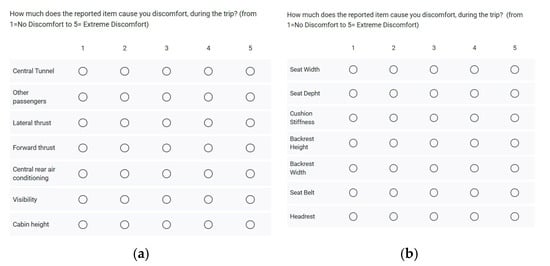
Figure 5.
Excerpts from the discomfort questionnaire. (a) The seat’s characteristics and (b) interiors’ parts.
- 3.
- Lastly, the third section was dedicated to investigating the physical discomfort perceived by participants, overall and in nine specific body regions (Figure 6).
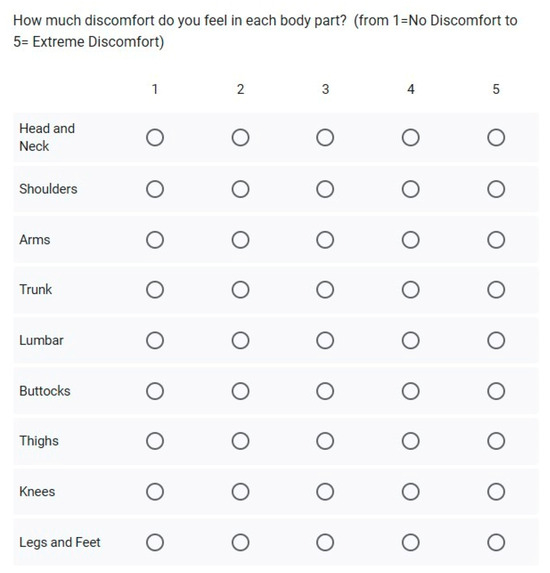 Figure 6. Excerpt from the discomfort questionnaire. Body part perceived discomfort.
Figure 6. Excerpt from the discomfort questionnaire. Body part perceived discomfort.
The discomfort measurement was assessed through a 5-point Likert scale (1 indicating “No discomfort” and 5 indicating “Extreme discomfort”).
3. Data Analysis and Result
An ex post analysis of the recorded movies has been performed in order to evaluate the behavior of subjects while performing the test and to exclude the one that performed too many movements or had an unpredictable behavior. The analysis of recordings prevented us from excluding any subject due to the very low possibility of performing movements: the general lack of space for legs and shoulders and the presence of two other people on the rear seat sides did not allow for any kind of strange movement; that happened in both the City Car and in the SUV.
The Wilcoxon signed rank test was performed to calculate whether there were significant differences between data, particularly for comparing experiences in both cars. Correlations between physical perceived discomfort (the overall and the local one) and the elements/factors involved in the interaction (seat, other passengers, lateral thrust during turns, thrust forward when braking, central rear air conditioning, the central tunnel, and visibility) were calculated with IBM® SPSS®, Statistics software, version 24, to evaluate if investigated factors affected discomfort or not. Spearman’s correlations were computed since data could be not normally distributed.
Table 2 shows the mean and the variance of overall discomfort perceived by the test participants for the City Car and the SUV. The overall discomfort for the City Car is higher than that for the SUV, with average values of 3.8 and 3, respectively. Although the average for both cars is similar, the variance is equal to 0.72 for the City Car and 1.16 for the SUV. For the City Car, therefore, there is less dispersion of the data. This shows that, for the City Car, although the participants had different anthropometric measurements, perceived discomfort in different body parts, and related the different elements of the passenger compartment differently, their perception related to the overall discomfort was similar.

Table 2.
Overall discomfort. Mean and Std. deviation for the City Car and the SUV.
Table 3 shows the number of participants who assigned that value of overall discomfort, for both the SUV and the City Car, through the questionnaire. The data shows that, for the City Car, the participants assigned discomfort scores concentrated between three, four, and five. For the SUV, however, the scores were concentrated between two, three, and four.

Table 3.
Overall discomfort questionnaire. Occurrence of answers for the City Car and the SUV.
Figure 7 and Figure 8 depict the trend of perceived discomfort related to the geometrical characteristics of the seat and elements/factors involved in the interaction. As can be seen from the graphs, for the City Car, the discomfort related to all the factors always has higher discomfort values. This result is in line with overall discomfort.
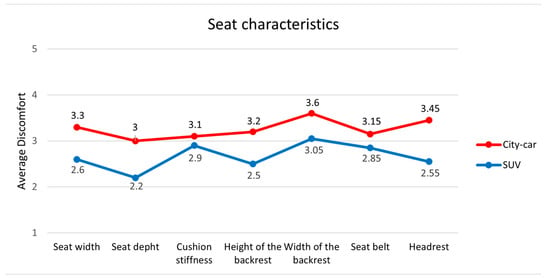
Figure 7.
Average discomfort, for each seat characteristic and for each car, evaluated through the questionnaire.
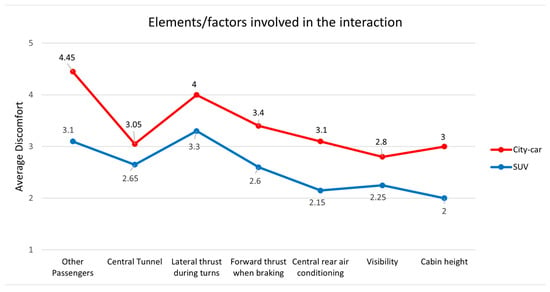
Figure 8.
Average discomfort, for each elements/factors involved in the interaction and for each car, evaluated through the questionnaire.
For both the SUV and the City Car, the most critical aspects for perceived discomfort are the width of the backrest (Figure 7), in terms of the seat itself; the interference with other passengers; and lateral thrust when cornering (Figure 8), regarding the factors involved in the interaction.
To understand which factors influenced global discomfort, a correlation analysis was carried out using the Spearman index (data not normally distributed). The most significant results are reported in Table 4. The first result was a complete lack of correlation among investigated comfort, discomfort parameters, anthropometric data, age, and weight; this was probably due to the limited number of subjects and the lack of space in both cars, which is perceived as uncomfortable, independent of individual body characteristics.

Table 4.
Correlation between elements/factors involved in the interaction, seat characteristics itself, and overall discomfort (the City Car and SUV). Spearman coefficients: ** indicates a strong linear correlation, and * indicates a moderate linear correlation.
Regarding local discomfort, Table 5 shows the average discomfort values for each part of the body, both for the City Car and for the SUV.

Table 5.
Average discomfort (obtained by questionnaires) for each body part (1 indicating “No discomfort” and 5 indicating “Extreme discomfort”).
Similarly, compared to overall discomfort, perceived discomfort by the body region is higher for the City Car. For the SUV, apart from the arms, the upper body appears to have a lower discomfort score (below three). Participants gave evidence that the head and neck, shoulders, back, and lumbar parts are therefore the parts less affected by discomfort. Statistical correlation analyses were conducted to evaluate what discomfort in the different parts of the body was related to. In particular, the analyses aimed to highlight whether (and which) the elements/factors involved in the interaction and the seat itself had an impact on local discomfort; Table 6 (City Car) and Table 7 (SUV) show the mentioned correlations.

Table 6.
Correlation between elements/factors involved in the interaction, seat characteristics itself, and local discomfort (City-car). Spearman coefficients: ** indicates a strong linear correlation, and * indicates a moderate linear correlation).

Table 7.
Correlation between elements/factors involved in the interaction, seat characteristics itself, and local discomfort (SUV). Spearman coefficients: ** indicates a strong linear correlation, and * indicates a moderate linear correlation).
For the City Car (Table 6), arm discomfort, which is the most critical part (Mean Value: 3.95, see Table 5), is related to the width of the backrest and the interference with other passengers. Air conditioning vents’ position is a critical element for the lower limbs (correlations significant at the 0.01 level). Furthermore, the characteristics of the cushion (stiffness and width) have a negative impact on the discomfort of the buttocks and thighs.
For the SUV, the seat characteristics seem to have a greater impact on local discomfort (higher correlation indices compared to the City Car) (Table 7). In particular, the most critical seating factors are the headrest, the width and firmness of the seat cushion, and the width of the backrest. Interference with other passengers greatly affects the discomfort of the arms and shoulders. Unlike the City Car, the lateral forces in curves prove to be an element of discomfort, especially for the legs, feet, and thighs.
4. Conclusions
This study aimed to investigate discomfort in the middle rear seat of two car segments—a City Car (Fiat Panda) and a C-SUV (Renault Arkana)—involving 20 participants. Discomfort was assessed using a multi-factor questionnaire and quantified through a 5-point Likert scale. The evaluation considered overall discomfort, localized body discomfort, vibrational discomfort, and discomfort due to interactions with specific interior elements.
Regarding overall discomfort, participants rated the overall discomfort significantly higher in the City Car (mean: 3.75 ± 0.72) than in the SUV (mean: 3.00 ± 1.16). In particular, 55% of participants rated the City Car experience at level 4 or 5 on the discomfort scale, compared to only 40% in the SUV.
The localized discomfort assessment revealed that the arms (mean discomfort: 3.95), knees (3.90), back (3.55), and thighs (3.55) were reported as the most affected in the City Car. In contrast, in the SUV, the arms (3.15) and legs/feet (3.25) still showed elevated discomfort but to a lesser degree.
The most critical aspects for the car, in terms of perceived discomfort, are the width of the backrest, interference with other passengers, and lateral human body thrust when cornering.
The correlation analysis was crucial to identifying the main issues related to the discomfort perceived in the central rear seat. Spearman’s correlation analysis revealed several statistically significant relationships between discomfort and interior elements. Backrest width and interference with other passengers correlated strongly with overall discomfort, both for the city car and the SUV. Discomfort in the upper limbs (the arm, shoulder, and back) was correlated with both backrest width and interference with the other passengers, indicating that spatial constraints were major factors. Other critical elements that were highlighted by statistical correlations were the position of the air conditioning vents, which created discomfort for the knees and legs, and the position and the shape of the central tunnel which forced passengers to adopt uncomfortable postures for their lower limbs.
In conclusion, the results highlighted that for both cars, the critical factors are the same: the positioning of the air conditioning vents, the interference with the other passengers on the rear seat, the headrest, and the width of the seat.
The results obtained from this analysis can offer interesting suggestions for automotive manufacturers to improve passengers’ travel. Regarding the seat design, results suggest increasing the width of the headrest and the backrest of the middle rear seat to reduce perceived discomfort, especially in the head and shoulder area. The headrest plays a fundamental role in the design of the vehicle, both regarding the safety of the occupants during a rear-end collision [49,50,51] and to counteract the continuous vibrations to which the subject is exposed to during a car journey [52,53]. Furthermore, there are growing concerns about the increase in motion sickness in autonomous cars for which an optimal head restraint could play a crucial role [54]. An optimal headrest should guarantee a better level of perceived comfort and reduce the risk of neck injuries in the event of a rear-end collision.
The lateral thrusts and the presence of side passengers are two other elements that affect perceived discomfort. For a car seat, lateral support is considered one of the essential elements for comfort [55,56]. Furthermore, it is demonstrated that poor lateral support leads to a heavier physical load competing with lateral movement [57]. A solution could concern the provision of lateral bolsters to “hold and wrap” the passenger. The lateral bolsters have a dual purpose: to reduce accidental interference between the arms and shoulders during curves and to contain the occupant’s motion during lateral thrusts. The results also showed that air conditioning was a crucial aspect of the discomfort perceived; the position of the air conditioning vents had a negative impact on overall discomfort and lower limbs. Various studies could be carried out to try to predict a different position of the air conditioning vents and to ensure the correct distribution of air conditioning or heating to avoid discomfort to passengers’ legs and knees.
In the end, we can answers the following research questions:
Does the middle rear seat problem exist? Yes, it exists, and the experiments highlight that all participants, in both car types, feel uncomfortable in the middle rear seat.
What do subjects feel during their experiences? The feeling of discomfort is caused by a few main issues. Statistical correlations show that the width of the backrest causes discomfort in the upper limbs while the air conditioning system and the central tunnel affect the lower limb’s discomfort, particularly for the knees and legs. Furthermore, the headrest proves to be a critical element affecting the discomfort perceived, particularly for the head.
How can we assess discomfort in the middle rear seat? An experiment performed on a short track is able to highlight middle rear seat issues related to discomfort. The use of a two-stage analysis (first among experts and second through questionnaires to people) was effective in developing a questionnaire for investigating the factors that should affect the perception of discomfort; users’ data and capabilities were gathered for a better understanding of subject-related habits and attitudes.
Is it possible to suggest solutions to reduce discomfort-related issues? Three elements emerged as critical for postural discomfort in the middle rear seat: the headrest, lateral bolsters, and the air conditioning system. A greater effort, therefore, should concern the headrest for the middle rear seat to better support the head during lateral accelerations and to guarantee a better level of perceived comfort; lateral bolsters to reduce the issues related to interference with other passengers and to hold the passenger during lateral accelerations; and rear conditioning vents’ position to guarantee the same comfort level for the middle rear passenger as the other passengers.
5. Limitations
This work shows the results of experiments regarding passenger behavior and discomfort in the middle rear seat. The results should have a helpful impact on vehicles’ interior design; nevertheless, some limitations need to be acknowledged.
The results are based on a pilot experimental test that involved 20 participants. This sample size cannot be considered sufficient to carry out an in-depth study of the issues, even if the sample is statistically representative. As the results are exploratory and indicative, it is necessary to repeat the tests with a larger number of participants.
For the pilot tests, the path chosen was a city route, and it was only 11.7 km long. This paper’s aim was to provide an instrument for investigating discomfort in the middle rear seat, so a short ride was chosen to perform the experiments. It is too short to deeply capture the dynamic changes in discomfort caused by long-term travel and the effect of vibrations. Further studies may consider scenarios with longer and more diverse road conditions, such as highways, bumpy roads, and long-term travel, to obtain more comprehensive data. In a longer ride, vibrations can probably cause different effects. Finally, only two car models were chosen to perform the road tests: a Fiat Panda and a Renault Arkana. Further studies may include other car models with different types of traction systems and power supplies. (For example, electric cars are not equipped with a central tunnel.) It would be interesting, additionally, to understand what changes occur in terms of (dis)comfort when using cars equipped with heated and ventilated seats or to investigate the effect of seat design (sporty, luxury, economy, etc.) or seat cover type (leather, Alcantara, synthetic, etc.) on discomfort feelings.
Author Contributions
Conceptualization, R.C. and A.N.; Methodology, R.C. and A.N.; Formal analysis, R.C.; Data curation, R.C.; Writing—original draft, R.C.; Writing—review & editing, A.N.; Supervision, A.N. All authors have read and agreed to the published version of the manuscript.
Funding
This research received no external funding.
Data Availability Statement
The data presented in this study are available on request from the corresponding author. Data is not available to the public for privacy reasons. If necessary, it will be anonymised and shared.
Conflicts of Interest
The authors declare no conflicts of interest.
References
- Bhise, V.D. Ergonomics in the Automotive Design Process 2012; CRC Press: Boca Raton, FL, USA, 2024. [Google Scholar]
- Barat, A.; Das, S. A Systematic Literature Review of Driver Behaviour in Blind Spot: Assessing Risk and Influencing Factors for Enhanced Ergonomics in Vehicle Design. Ergonomics 2024, 67, 1765–1781. [Google Scholar] [CrossRef]
- Zhang, C.; Duan, Y.; Pan, H.; Chen, S. Investigation into the Comfort of Automotive Seating through the Integration of Affective Engineering Design. In Proceedings of the ITOEC 2023—IEEE 7th Information Technology and Mechatronics Engineering Conference, Chongqing, China, 15–17 September 2023; pp. 2391–2395. [Google Scholar]
- Lee, A.T. Driving Behavior: Managing Resources in a Complex Task; CRC Press: Boca Raton, FL, USA, 2023. [Google Scholar]
- Hiemstra-van Mastrigt, S.; Groenesteijn, L.; Vink, P.; Kuijt-Evers, L. Predicting Passenger Seat Comfort and Discomfort on the Basis of Human, Context and Seat Characteristics: A Literature Review. Ergonomics 2016, 60, 889–911. [Google Scholar] [CrossRef]
- Haseeb, A.; Mitra, R. Travel Behaviour Changes among Young Adults and Associated Implications for Social Sustainability. Transp. Res. Part A Policy Pract. 2024, 187, 104189. [Google Scholar] [CrossRef]
- Battié, M.C.; Videman, T.; Gibbons, L.E.; Manninen, H.; Gill, K.; Pope, M.; Kaprio, J. Occupational Driving and Lumbar Disc Degeneration: A Case-Control Study. Lancet 2002, 360, 1369–1374. [Google Scholar] [CrossRef]
- Dankaerts, W.; O’Sullivan, P.; Burnett, A.; Straker, L. Altered Patterns of Superficial Trunk Muscle Activation during Sitting in Nonspecific Chronic Low Back Pain Patients: Importance of Subclassification. Spine 2006, 31, 2017–2023. [Google Scholar] [CrossRef] [PubMed]
- Kyung, G.; Nussbaum, M. Driver Sitting Comfort and Discomfort (Part II): Relationships with and Prediction from Interface Pressure. Int. J. Ind. Ergon. 2008, 38, 526–538. [Google Scholar] [CrossRef]
- Zhang, H.; Ni, D.; Ding, N.; Sun, Y.; Zhang, Q.; Li, X. Structural Analysis of Driver Fatigue Behavior: A Systematic Review. Transp. Res. Interdiscip. Perspect. 2023, 21, 100865. [Google Scholar] [CrossRef]
- Reed, M.P.; Schneider, L.W.; Ricci, L.L. Survey of Auto Seat Design Recommendations for Improved Comfort; Lear Seating Corporation: Southfield, MI, USA, 1994. [Google Scholar]
- Kolich, M. Automobile Seat Comfort: Occupant Preferences vs. Anthropometric Accommodation. Appl. Ergon. 2003, 34, 177–184. [Google Scholar] [CrossRef]
- Kolich, M. Predicting Automobile Seat Comfort Using a Neural Network. Int. J. Ind. Ergon. 2004, 33, 285–293. [Google Scholar] [CrossRef]
- Kolich, M. A Conceptual Framework Proposed to Formalize the Scientific Investigation of Automobile Seat Comfort. Appl. Ergon. 2008, 39, 15–27. [Google Scholar] [CrossRef]
- Bubb, H.; Grünen, R.E.; Remlinger, W. Anthropometric Vehicle Design. In Automotive Ergonomics; Bubb, H., Bengler, K., Grünen, R.E., Vollrath, M., Eds.; Springer Fachmedien: Wiesbaden, Germany, 2021; pp. 343–468. ISBN 978-3-658-33941-8. [Google Scholar]
- Fazlollahtabar, H. A Subjective Framework for Seat Comfort Based on a Heuristic Multi Criteria Decision Making Technique and Anthropometry. Appl. Ergon. 2010, 42, 16–28. [Google Scholar] [CrossRef] [PubMed]
- Naddeo, A.; Memoli, S. Postural Comfort inside a Car: Development of an Innovative Model to Evaluate the Discomfort Level. SAE Int. J. Passeng. Cars Mech. Syst. 2009, 2, 1065–1070. [Google Scholar] [CrossRef]
- Naddeo, A.; Cappetti, N.; Ippolito, O. Dashboard Reachability and Usability Tests: A Cheap and Effective Method for Drivers’ Comfort Rating. SAE Tech. Pap. 2014, 1, 0455. [Google Scholar] [CrossRef]
- Vergara, M.; Page, Á. Relationship between Comfort and Back Posture and Mobility in Sitting-Posture. Appl. Ergon. 2002, 33, 1–8. [Google Scholar] [CrossRef]
- Na, S.; Lim, S.; Choi, H.-S.; Chung, M.K. Evaluation of Driver’s Discomfort and Postural Change Using Dynamic Body Pressure Distribution. Int. J. Ind. Ergon. 2005, 35, 1085–1096. [Google Scholar] [CrossRef]
- Kolich, M.; Taboun, S.M. Ergonomics Modelling and Evaluation of Automobile Seat Comfort. Ergonomics 2004, 47, 841–863. [Google Scholar] [CrossRef] [PubMed]
- Zhao, M.; Beurier, G.; Wang, H.; Wang, X. Driver Posture Monitoring in Highly Automated Vehicles Using Pressure Measurement. Traffic Inj. Prev. 2021, 22, 278–283. [Google Scholar] [CrossRef] [PubMed]
- Warska, M.; Barburski, M.; van Langenhove, L. Textile Elements for Car Seat to Improve User’s Driving Comfort. J. Ind. Text. 2019, 51, 513–539. [Google Scholar] [CrossRef]
- Naddeo, A.; Morra, A.; Califano, R. Human-Centered Design and Manufacturing of a Pressure-Profile-Based Pad for Better Car Seat Comfort. Machines 2024, 12, 374. [Google Scholar] [CrossRef]
- De Looze, M.P.; Kuijt-Evers, L.F.; Van Dieen, J.A. Sitting Comfort and Discomfort and the Relationships with Objective Measures. Ergonomics 2003, 46, 985–997. [Google Scholar] [CrossRef]
- Vink, P.; Hallbeck, S. Editorial: Comfort and Discomfort Studies Demonstrate the Need for a New Model. Appl. Ergon. 2012, 43, 271–276. [Google Scholar] [CrossRef]
- Hirao, A.; Naito, S.; Yamazaki, N. Pressure Sensitivity of Buttock and Thigh as a Key Factor for Understanding of Sitting Comfort. Appl. Sci. 2022, 12, 7363. [Google Scholar] [CrossRef]
- Förstberg, J. Ride Comfort and Motion Sickness in Tilting Trains. Ph.D. Thesis, KTH Royal Institute of Technology, Stockholm, Sweden, 2000. [Google Scholar]
- Ebe, K.; Griffin, M.J. Qualitative Models of Seat Discomfort Including Static and Dynamic Factors. Ergonomics 2000, 43, 771–790. [Google Scholar] [CrossRef] [PubMed]
- Ebe, K.; Griffin, M.J. Factors Affecting Static Seat Cushion Comfort. Ergonomics 2001, 44, 901–921. [Google Scholar] [CrossRef]
- Garcia Solano, J. Generation of Ride Comfort Index. Bachelor’s Thesis, Universidad Politecnica de Barcelona, Barcelona, Spain, 2014. [Google Scholar]
- Reed, M.P.; Manary, M.A.; Flannagan, C.A.; Schneider, L.W. Effects of Vehicle Interior Geometry and Anthropometric Variables on Automobile Driving Posture. Hum. Factors 2000, 42, 541–552. [Google Scholar] [CrossRef]
- Joseph, A. Sember The Biomechanical Relationship of Seat Design to the Human Anatomy, 1st ed.; CRC Press: Boca Raton, FL, USA, 1994; pp. 221–229. [Google Scholar]
- Hiemstra-van Mastrigt, S.; Kamp, I.; van Veen, S.A.T.; Vink, P.; Bosch, T. The Influence of Active Seating on Car Passengers’ Perceived Comfort and Activity Levels. Appl. Ergon. 2015, 47, 211–219. [Google Scholar] [CrossRef]
- Quattelbaum, B.; Stylidis, K.; Braun, A.; Söderberg, R. Preliminary Study on Perceived Comfort of Car Seats: A Quantitative Approach to Visual Cues. Procedia CIRP 2021, 104, 116–121. [Google Scholar] [CrossRef]
- Hatoum, O.; Ghaddar, N.; Ghali, K.; Ismail, N. Back-Cooling Car-Seat System Using Embedded Heat Pipes to Improve Passenger’s Comfort and Reduce Fuel Consumption. In Proceedings of the 12th Conference on Sustainable Development of Energy, Water and Environment Systems (SDEWES2017), Dubrovnik, Croatia, 4–8 October 2017. [Google Scholar]
- Vink, P.; Bazley, C.; Kamp, I.; Blok, M. Possibilities to Improve the Aircraft Interior Comfort Experience. Appl. Ergon. 2012, 43, 354–359. [Google Scholar] [CrossRef]
- Mohammad Yusof, N.A.D.; Karuppiah, K.; Mohamad Jamil, P.A.S.; Khalid, M.S.; Mohd Tamrin, S.B.; Sadeghi Naeini, H. Development of a High-Powered Motorcycle Seat Discomfort Survey (MSDS): Traffic Police Motorcycle. Int. J. Ind. Ergon. 2022, 92, 103374. [Google Scholar] [CrossRef]
- Mohammad Yusof, N.; Karuppiah, K.; Md Tamrin, S.; Rasdi, I.; Mohamad Jamil, P.A.S. Likert Scale vs. Visual Analogue Scale on Vehicle Seat Discomfort Questionnaire: A Review. Malays. J. Med. Health Sci. 2019, 15, 159–165. [Google Scholar]
- Available online: https://Jestafreak.Com/Explore-the-Car-Brand-Pyramid (accessed on 25 July 2025).
- Fisher, R.A. Statistical Methods for Research Workers. In Breakthroughs in Statistics: Methodology and Distribution; Kotz, S., Johnson, N.L., Eds.; Springer: New York, NY, USA, 1992; pp. 66–70. ISBN 978-1-4612-4380-9. [Google Scholar]
- Asua, E.; Gutiérrez-Zaballa, J.; Mata-Carballeira, O.; Ruiz, J.A.; del Campo, I. Analysis of the Motion Sickness and the Lack of Comfort in Car Passengers. Appl. Sci. 2022, 12, 3717. [Google Scholar] [CrossRef]
- Tourangeau, R. Cognitive Aspects of Survey Measurement and Mismeasurement. Int. J. Public Opin. Res. 2003, 15, 3–7. [Google Scholar] [CrossRef]
- Desselle, S. Construction, Implementation, and Analysis of Summated Rating Attitude Scales. Am. J. Pharm. Educ 2005, 69, 97. [Google Scholar] [CrossRef]
- Groves, R.; Fowler, F.; Couper, M.; Lepkowski, J.; Singer, E.; Tourangeau, R. Survey Methodology; John Wiley & Sons: Hoboken, NJ, USA, 2004; p. 561. [Google Scholar]
- Salant, P.; Dillman, D.A. How to Conduct Your Own Survey; John Wiley & Sons: Hoboken, NJ, USA, 1994; ISBN 978-0-471-01273-3. [Google Scholar]
- Presser, S.; Blair, J. Survey Pretesting: Do Different Methods Produce Different Results? Sociol. Methodol. 1994, 24, 73. [Google Scholar] [CrossRef]
- Rothgeb, J.M.; Willis, G.; Forsyth, B.H. Questionnaire Pretesting Methods. Do Different Techniques and Different Organizations Produce Similar Results. Bull. Sociol. Methodol. Bull. Méthodol. Sociol. 2007, 96, 5–31. [Google Scholar] [CrossRef]
- Yang, Y.S.; Kim, Y.S.; Jeon, E.S. Behavior Analysis of Active and Proactive Headrest during Low-Velocity Rear-End Collisions. Appl. Sci. 2020, 10, 1451. [Google Scholar] [CrossRef]
- Petru, M. Development and Optimization of the Headrests Seat According the Signal Whiplash. Bull. Appl. Mech. 2010, 6, 34–40. [Google Scholar]
- Gheorghe Marius, C.; Ionut Alexandru, G.; Daniel Dragos, T.; Florin Daniel, T. Comparative Analysis of Driver’s Motion Using Different Headrest Positions during the Rear-End Collision. IOP Conf. Ser. Mater. Sci. Eng. 2022, 1220, 12046. [Google Scholar] [CrossRef]
- Niroobakhsh, M.; Gheibollahi, H.; Masih-Tehrani, M. The Key Role of Headrest Optimization in Driver Comfort. Int. J. Acoust. Vib. 2019, 24, 592–599. [Google Scholar] [CrossRef]
- Franz, M.; Durt, A.; Zenk, R.; Desmet, P.M.A. Comfort Effects of a New Car Headrest with Neck Support. Appl. Ergon. 2012, 43, 336–343. [Google Scholar] [CrossRef]
- Kato, K.; Suzuki, K.; Honda, C. Reduction of Carsickness Using a Headrest with Support to Suppress Head Motion. In Proceedings of the Comfort Congress, Nottingham, UK, 2–3 September 2021. [Google Scholar]
- O’Bannon, T.; Thomas, B.; Weierstall, M.; Shahid, M.; Khaja, I. Characterization of Seat Lateral Support as a Mechanical Behavior. SAE Int. J. Adv. Curr. Pract. Mobil. 2020, 2, 3364–3383. [Google Scholar] [CrossRef]
- Coelho, D.A.; Dahlman, S. A Pilot Evaluation of Car Seat Side Support: Leading to a Redefinition of the Problem. Int. J. Ind. Ergon. 1999, 24, 201–210. [Google Scholar] [CrossRef]
- Okiyama, H.; Michida, N.; Nishikawa, K.; Nouzawa, T. Objective Evaluation of Seat Lateral Supportfor Cornering. SAE Trans. 2001, 110, 306–310. [Google Scholar]
Disclaimer/Publisher’s Note: The statements, opinions and data contained in all publications are solely those of the individual author(s) and contributor(s) and not of MDPI and/or the editor(s). MDPI and/or the editor(s) disclaim responsibility for any injury to people or property resulting from any ideas, methods, instructions or products referred to in the content. |
© 2025 by the authors. Licensee MDPI, Basel, Switzerland. This article is an open access article distributed under the terms and conditions of the Creative Commons Attribution (CC BY) license (https://creativecommons.org/licenses/by/4.0/).